Essay On Renaissance Art – Structure/Outline
- Introduction
- History of Renaissance Art
- Renaissance Art in Italy
- Characteristics of Renaissance Art
- Causes of Renaissance
- Effect of Humanism on Renaissance Art
- Effect of Religion on Renaissance Art
- Different Artists and Their Status
- FAQs
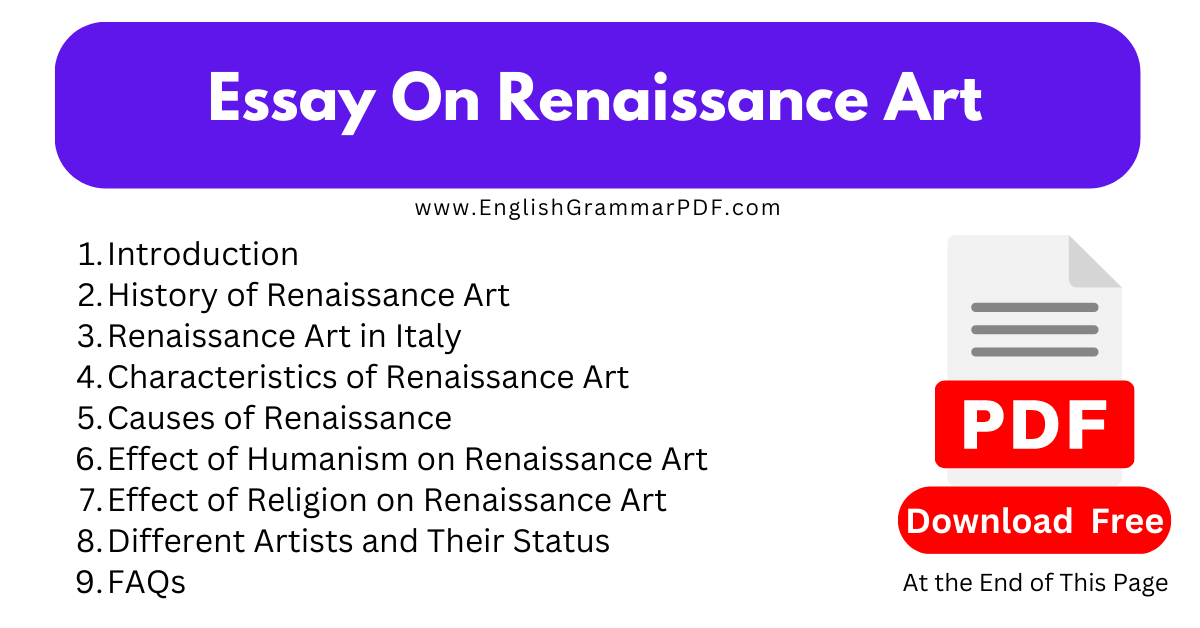
Introduction
Renaissance Art is a period of European art history that emerged in Florence, Italy during the 14th century and lasted until the 17th century. This period saw great advances in technological innovation, exploration, and religious reformation.
As such, renaissance art encompasses a diverse array of artistic styles built upon a new definition of beauty that incorporated the classical ideal with the real-life human form. Characteristic Renaissance paintings combine mathematical harmony with the wealth of nature while capturing emotion, movement, and the spirit of life itself.
The paintings employ vibrant colors, realistic detail, and perspective to demonstrate the grand use of space; sculptures display robustness and an understanding of anatomy; architecture combines ancient wisdom with modern invention to create stunning man-made structures.
During this bustling period of creativity, some of humankind’s brightest minds flourished in every field imaginable: from Michelangelo to Galileo; from Leonardo da Vinci to Raphael; from Shakespeare to Petrarch — the inventiveness remains on full display today in our museums, churches, and civic centers throughout Europe.
History of Renaissance Art
Renaissance art emerged out of the medieval period, which was characterized by dark colors, religious symbolism, and a focus on death and the afterlife. Renaissance artists aimed to capture the beauty of real life, rejecting the idea that art should only be symbolic or traditional.
This revolutionary movement was born in Florence, Italy during the 14th century; though it eventually spread throughout Europe, Italy was the starting point. During this period, Renaissance art became more secular rather than religious, focusing on new concepts such as humanism and individualism over traditional beliefs.
The emergence of the printing press during this era allowed for increased circulation of knowledge, facilitating easier access to scientific discoveries, books, and general information that contributed to the new way of thinking. This period also saw an increased emphasis on individual creativity and imagination, resulting in a vibrant art movement that celebrated everyday life and its beauty.
Renaissance Art in Italy
Renaissance art in Italy was supported by the powerful Medici family and other wealthy patrons who commissioned famous works like Michelangelo’s David and Leonardo da Vinci’s Last Supper.
During this period, Florence became a major center for the arts with numerous art academies springing up throughout the city. The two most influential were the Accademia delle Belle Arti di Firenze, founded in 1563, and the Accademia di San Luca, founded in 1593.
These institutions taught students the classical principles of art and encouraged them to develop their unique style. Many of these new artists rejected the traditional religious themes and instead adopted a more secular approach that focused on the beauty of the human form.
Artists such as Michelangelo, Leonardo da Vinci, and Raphael were all students at one of the Accademia’s and went on to become some of the most famous Renaissance painters in history.
Characteristics of Renaissance Art
Renaissance art is characterized by its lifelike nature and attention to detail, often capturing moments in time with realistic precision. Painters and sculptors used natural perspective to create the illusion of 3D space on 2D surfaces. There was a focus on proportion and mathematical harmony, as many artists attempted to replicate the perfection of classical antiquity through their works.
Renaissance art also showcased humanistic themes such as passion, emotion, and nature, often featuring central figures in moments of restful contemplation or vibrant celebration. A few other notable elements of Renaissance art include the use of bold colors, dynamic poses, and intricate details that capture the complexity of human nature and life itself.
Causes of Renaissance
Many factors contributed to the emergence of Renaissance art, but a few key elements are worth noting. Firstly, there was increased global exploration during this period which led to increased contact with classical art and ideas. Secondly, there was a rise in new scientific discoveries which allowed for a greater understanding of the physical world. Lastly, religious reformation saw the emergence of humanism and individualism, challenging traditional beliefs and creating new ways of thinking about life.
All these elements combined to create an atmosphere catalyzed by creativity and artistic expression. Renaissance art is a vibrant period of creativity that celebrates the beauty and complexity of human life. The movement focused on lifelike realism, proportion, and mathematical harmony, highlighting individualism and nature in its works.
This period saw an increased emphasis on the physical world over traditional beliefs, leading to revolutionary thinking about art and life in general. Renaissance art continues to influence and inspire today, captivating the imagination with its stunning man-made structures.
Effect of Humanism on Renaissance Art
The rise of humanism in the Renaissance period had a major impact on art. Humanists believed that man was the measure of all things, as opposed to traditional religious beliefs which held God as the ultimate source of truth.
As a result, Renaissance artists no longer looked to religion or nature for inspiration, but instead focused on the potential of individual human creativity. The focus on humans as the center of art led to works that showcased complex emotions and lifelike realism instead of classical ideals or religious themes. This new approach to art had a major impact on the development of Renaissance art, leading to some of the most stunning works ever created.
Effect of Religion on Renaissance Art
Despite the emergence of humanism during the Renaissance period, religion still had a major influence on art. While traditional religious themes were no longer as prominent in paintings and sculptures, many works still featured symbols and icons from Christianity.
Additionally, some of the most famous Renaissance painters such as Michelangelo and Leonardo da Vinci painted scenes from the Bible or religious figures. These works often showcased the potential of human creativity and artistry, using realistic techniques to capture the majesty of religion and its effects on people’s lives. Religion was a major factor in the development of Renaissance art, inspiring some of the most iconic works from this period.
Different Artists and Their Status
The Renaissance period saw the emergence of some of the most famous painters and sculptors in history. Some of these renowned artists include Leonardo da Vinci, Michelangelo, Raphael, and Botticelli.
These figures were held in high esteem during their lifetimes, often enjoying wealth and recognition from powerful rulers such as the Medici family. This level of status and recognition was unprecedented in the art world and these artists remain some of the most recognizable figures to this day.
FAQs
Why renaissance art is important?
Renaissance art is important because it marks a period of renewed interest in classical art and ideas, combined with revolutionary thinking about life and creativity. The movement focused on lifelike realism, proportion, and mathematical harmony, highlighting individualism and nature in its works.
What was the art style during Renaissance?
The art style of the Renaissance period featured lifelike realism, proportion, and mathematical harmony. This was a major departure from classical works which focused on idealized versions of human figures and religious scenes.
Which is a key feature of Renaissance paintings?
One of the key features of Renaissance paintings is their focus on lifelike realism, highlighting individualism and nature in their works. This was achieved through careful attention to light, shadow, and facial expressions, creating stunningly realistic images that captivated viewers.
What is the renaissance art period?
The Renaissance art period began in the mid-1400s and lasted until the early 1700s. This period is often considered to be one of the most influential eras in art history, producing some of the most iconic works in human history.
What is humanism in renaissance art?
Humanism was a philosophical movement that emerged during the Renaissance period, emphasizing human potential and creativity.
Essay On Renaissance Art (Pictures and PDF)
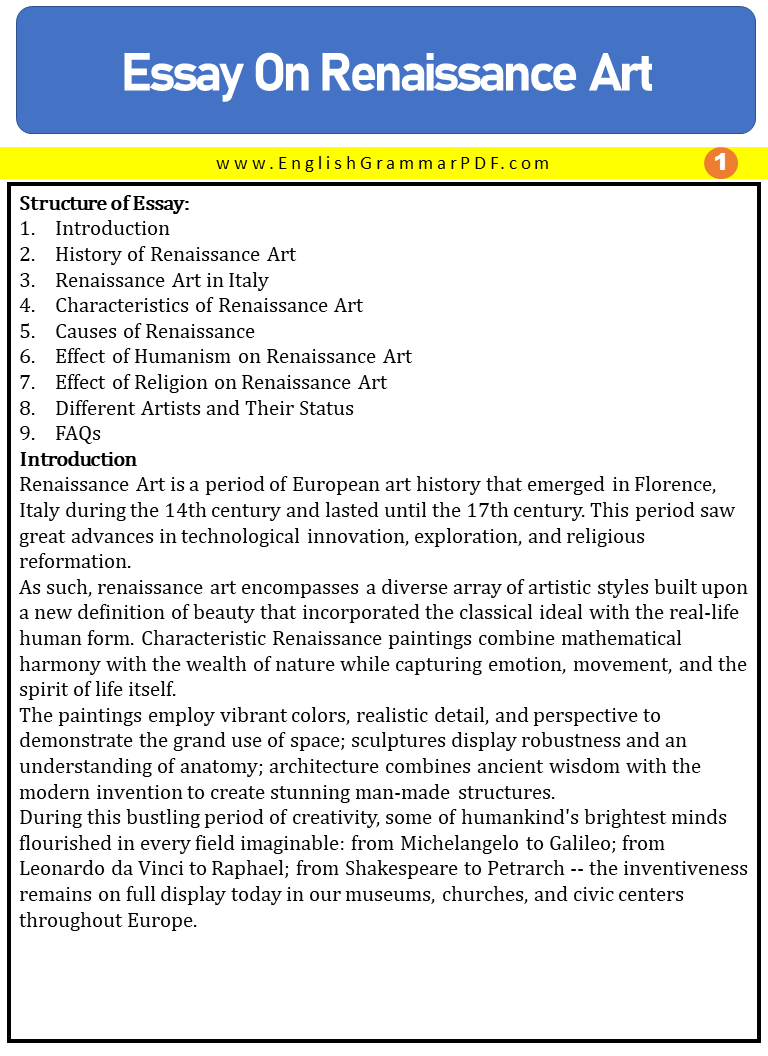
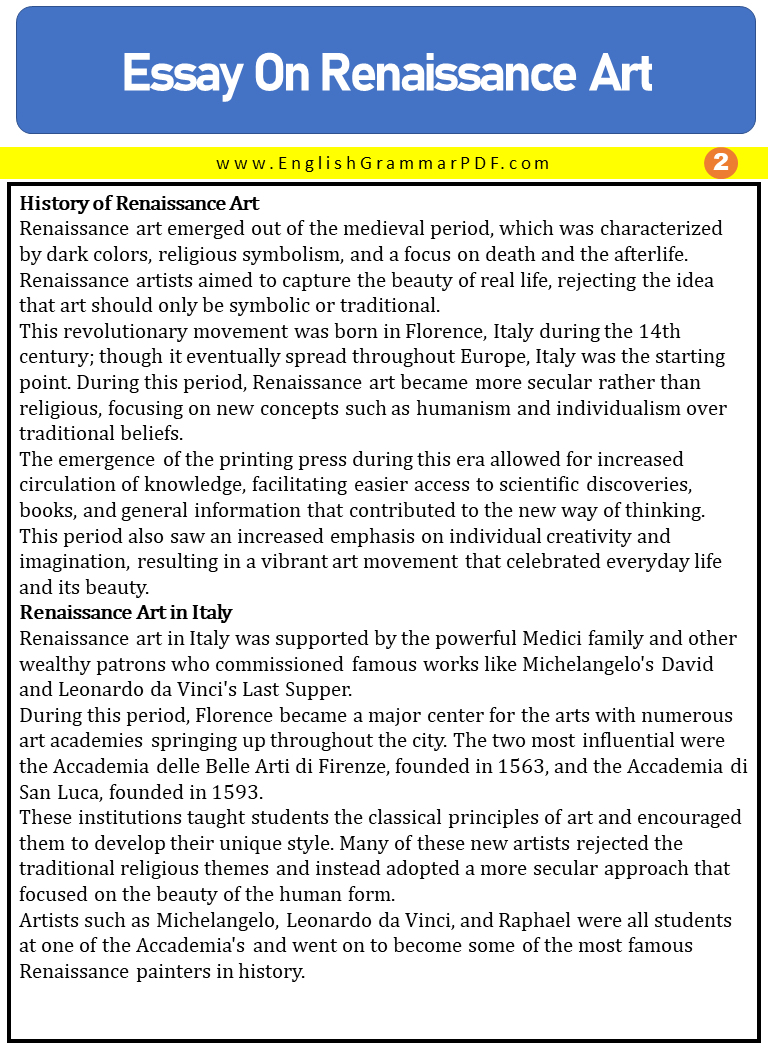
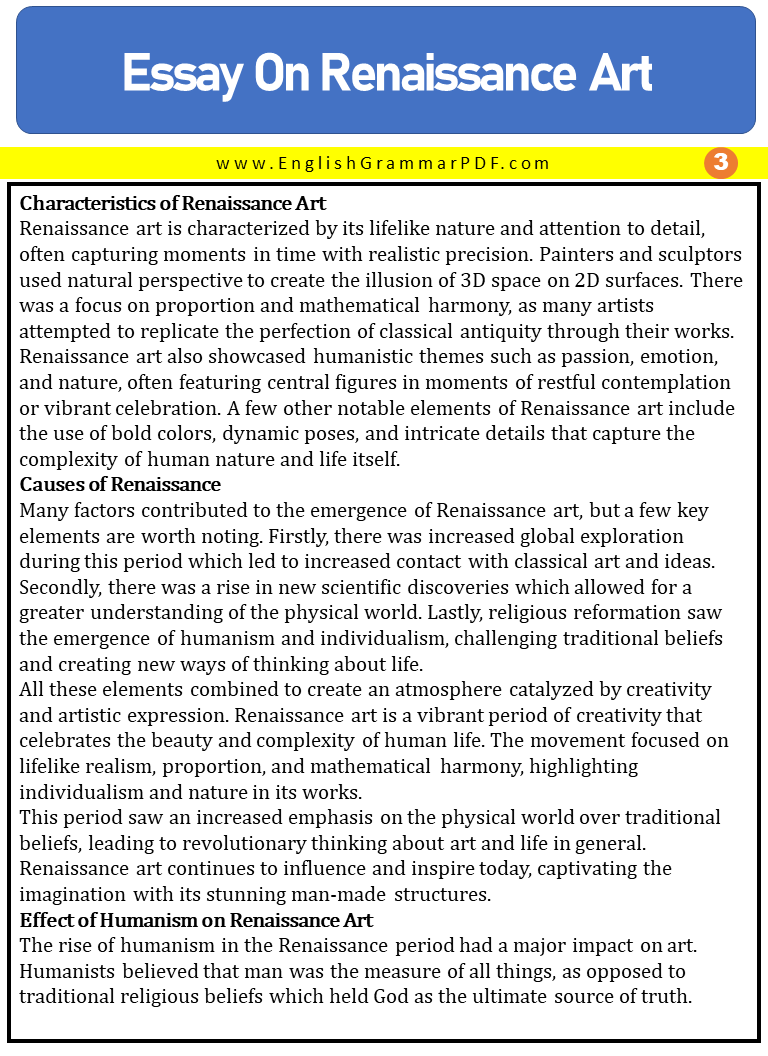
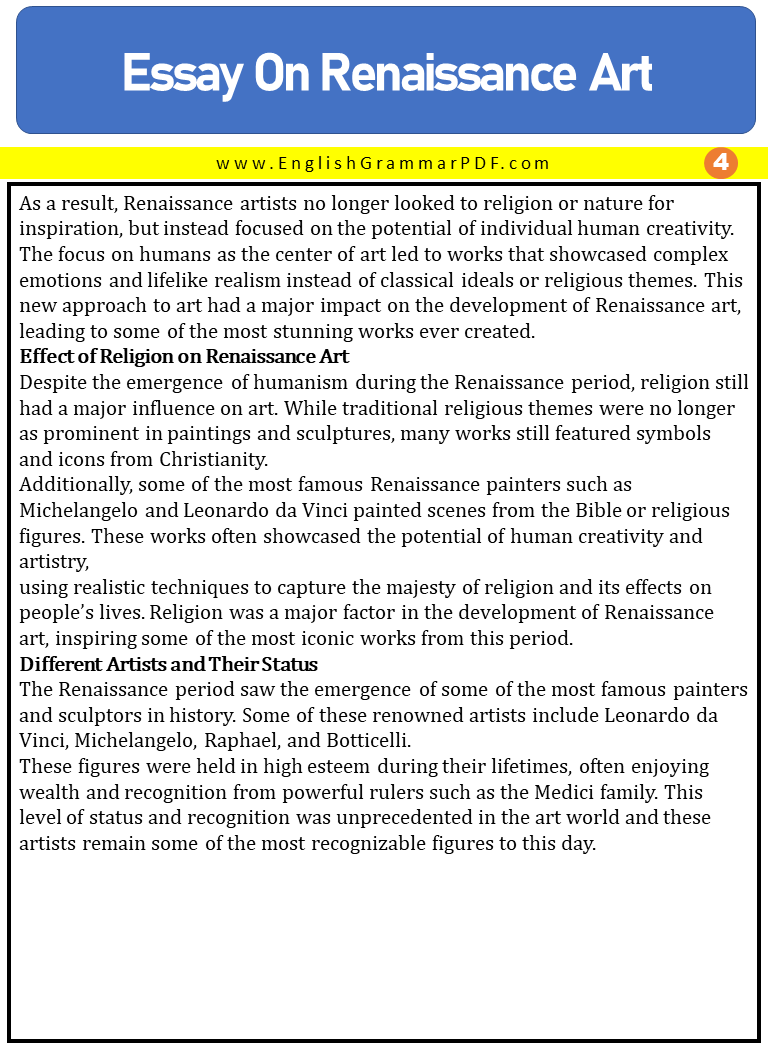
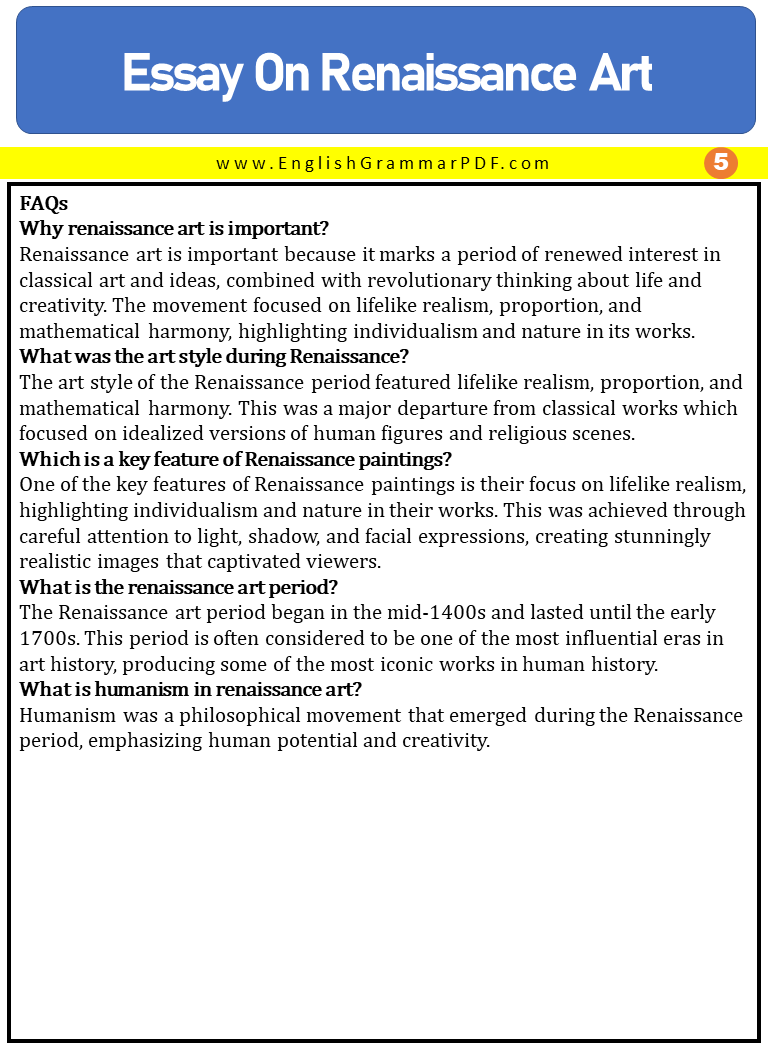
Related: Essay On Standardized Testing
Download this essay in PDF, below.


